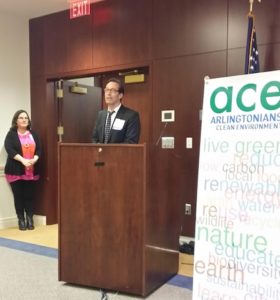
By ELENA J. KOCHNOWICZ with CAROL McCAFFREY and JEN RUSK
Eco-friendly, green standards, eco-labels… These are all common words used in sustainability conversations, but consistent definitions and standards can be hard to come by. Better definitions could help consumers and organizations make smart purchases that are good for people and the planet.
On March 8, 2017, the Annual Meeting of Arlingtonians for a Clean Environment (ACE) was held under the theme “What It Means to Be Greener: Eco-labels and Standards for Environmentally Preferable Products.” The meeting included exhibits from Leaders in Energy, Arlington County Green Home Choice, LED Source DC, and several others.
Jay Fisett, Arlington County Board Chair, opened up the annual ACE Meeting with a few remarks regarding ACE and what sustainability and environmental responsibility means to Arlington. The Arlington County government (VA) believes in clean water, clean air, and renewable energy. Every time you face a challenge, you also see opportunity.

Creating change can happen in people’s own backyards. In 2016, under a plan developed in 2015 and executed by ACE, they held eight stream cleanups, 94 trees were planted under the Tree Canopy Plan, and 119 affordable homes were made more energy efficient through ACE’s award-winning Energy Masters program. ACE is hosting its next Potomac Watershed Cleanup on April 8, 2017, from 10 a.m.-12 p.m. on North Glebe Road and Chain Bridge Road, Arlington, Virginia 22207.
Getting involved in community projects, such as those sponsored by Arlingtonians for a Clean Environment, is a great way to become more proactive on environmental responsibility. Kids are welcome too!
What if sustainability were valued as much as safety, quality, and price?
The products that we come into contact with everyday have a lifecycle, a timeline of their development and usability; from design, assembly, and transport to the consumer, to the total usage by the consumer, and finally to disposal or recycling. Every moment of a product’s life contributes to its sustainability factor, and every moment has an impact due to the interconnectedness of the world, like a ripple effect. For example, sealing windows in buildings helps to cut down on energy use, but then creates indoor pollution, since there is no direct access to the outside.
To help mitigate the negative aspects of the ripple effect, consumers need to demand transparency and data on their products’ lifecycles. Where did the parts come from, where were they assembled, did they use fossil fuels to transport the product?
However, when consumers are given information, it often causes information overload, confusion, and frustration. There can be a difficult balance between fulfilling the consumer Right to Know information and deciding how much information is needed and how to present it. For instance, nutrition labels often lead to more questions than answers. With regard to sustainability, the groups responsible for developing standards can diverge and even conflict with each other. Now there are hundreds of eco-labels, all with their own regulations, criteria, and definitions.
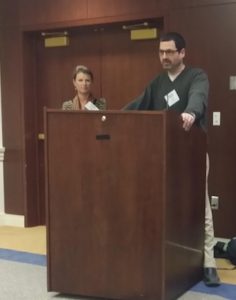
Alison Kinn Bennett, Senior Advisor for sustainable products and purchasing at the U.S. Environmental Protection Agency (EPA), is currently heading the EPA’s efforts to create federal programs to assess environmental performance standards and eco-labels for government purchases.
The EPA is working on standardizing these labels to facilitate eco-friendly purchasing for federal agencies, and to improve understanding of the purchases. Since the federal government is responsible for billions of dollars in procurement, they are able to make a huge impact when choosing what to buy through institutional purchasing power. Products used by the government end up being used throughout the agencies, and in turn may gain greater exposure across the nation and around the world.
Transparency and standardization of supply chains and labels for green products can change the way sustainability is viewed by consumers, making it as important as safety and quality.
Defining green products
Jason Holstine, of the Amicus Green Building Center, is currently using his 14 years of experience with creating and executing sustainable projects for public and private entities to offer products that are eco-friendly, sustainable, and budget-friendly with Amicus.
According to Holstine, there is no true definition of what constitutes a “green product.” Would they be recycled, organic, or all-natural? Labels are used as signals to consumers to help them make purchases, but sometimes what’s on the label can be too good to be true. There is a push from consumers to increase transparency across the entire chain of production, to remove harmful chemicals from homes, and to have the information at their fingertips.
There are many organizations that work with companies to create labels to inform the consumer, but some are limited in the scope of products that are covered, while others are umbrella groups that look into various products. Examples of both types are the Forest Stewardship Council, which ensures that wood products are responsibly and sustainably forested, and the U.S. Green Building Council, which examines all levels of sustainability in building projects.
Making forward-thinking purchasing decisions
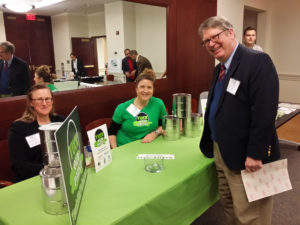
In terms of the government’s involvement with researching and dispensing information on sustainable, clean, and non-harmful products, there tends to be a trend in how much people rely on the government to provide protections and information. When the government heavily invests in agencies such as the EPA, people tend to use that information and do less individual research. When the government cuts such resources, people take matters into their own hands in researching companies’ environmental policies.
This creates an interesting dynamic, as companies are still being held to high standards under the spotlight of the Internet and social media, even when the government is no longer as strong as a source of information.
Consumers have more power to effect change than they know, but it takes time to do research, ask hard questions, and ensure that companies are held responsible for their products and any negative impacts on the health of people and the planet. We have to hold ourselves accountable for making these choices and weighing the up-front costs, durability, product reuse, and long-term cost savings. Products may cost less on the shelf, but end up costing taxpayer dollars in cleanup operations to reverse pollution and damage.
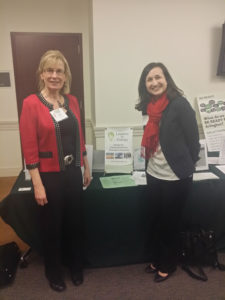
From a product communications standpoint, it is important to make statements about the environment more personal by using “our” instead of “the” environment. This can help consumers bring the message home as they make these decisions. We are all connected by the air, water, and land, so what happens in one part of the world ultimately has a ripple effect on our side. There is no escaping that.
More and more we are seeing the products consumers use day-to-day labeled as green, and older products are being phased out. The difficulty comes in determining, measuring, and communicating the minimum standard of quality. Some standards have a variety of tiers that complicate the matter. Increased access to green products in turn increases the scrutiny on the accuracy of advertising and labeling as green, thereby increasing the need for standardized and clear definitions of terms associated with eco-friendly labels.
Conclusion
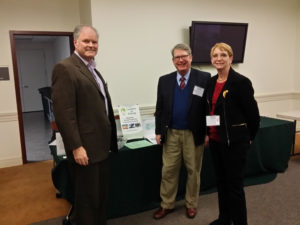
All people should recognize their role as caretakers of our planet. But the green economy has led to new roles and responsibilities, whether from the perspective of a government agency or as an ordinary consumer. That’s why people need to step up, do research, and discover for themselves what being a caretaker means. If people demand more from their companies and government agencies, and make sustainability a constant personal mission, then real progress can be made on making products more environmentally responsible, both on the label and in fact.
None of this happens overnight, but with perseverance and dedication, subjective interpretations can become more objective; and individuals, small businesses, national and multinational organizations, and governments can be held accountable for their impact on the environment.


Leave a Reply